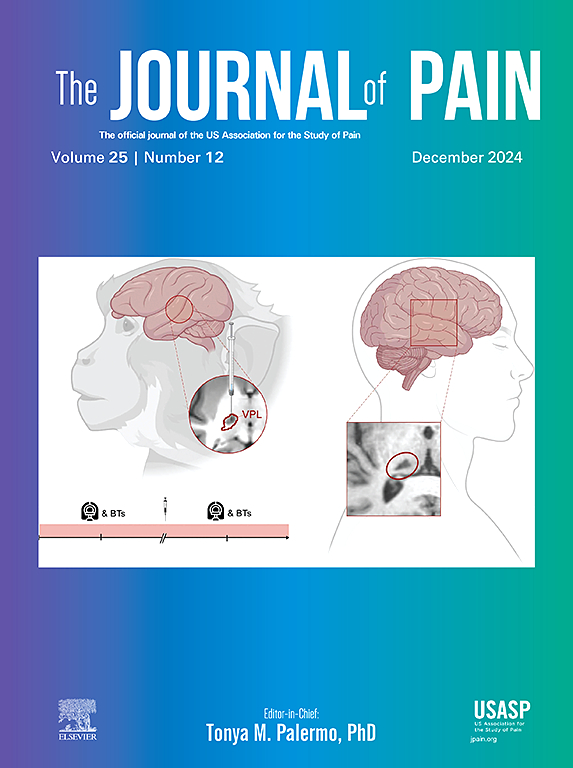Opposing effects of mu opioid receptors on dopamine D1 and D2 receptor expressing neurons in opioid mediated antinociception
IF 4
2区 医学
Q1 CLINICAL NEUROLOGY
引用次数: 0
Abstract
There is extensive interaction between systems involved in pain processing and motivation, where the aberrant functioning of salience circuits likely contributes to chronic pain, as well as increased susceptibility to opioid misuse and opioid use disorder. This study asks to what extent mu opioid receptors (MORs) in dopamine D1 receptor (D1R), D2 receptor (D2R) or adenosine A2a receptor (A2aR) expressing neurons contribute to the expression of pain and opioid antinociception. We ablated MORs in dopamine receptor expressing neurons by breeding D1R, D2R or A2aR-cre with MORloxP mice, which was confirmed by RNAscope multiplex fluorescent in situ hybridization. To determine the role of these MORs in nociception, we assessed the nociceptive responses in the hot plate and formalin tests with and without treatment with oxycodone (3 mg/kg, i.p.). Pain-like behavior in a thermal assay, mechanical thresholds following nerve injury, and the formalin test were not altered by genotype. However, oxycodone-induced antinociception in the formalin test was differentially altered. Opioid antinociception was attenuated in mice that lacked MORs in D1R neurons, but was enhanced when MORs were ablated in either the D2R and A2aR neurons. In contrast, there was no effect of genotype on oxycodone-induced antinociception in the thermal nociceptive test. Together, these data show that MORs in D1R expressing neurons is necessary for opioid-induced antinociception in a model of tonic inflammatory pain, but not acute thermal pain. Whereas, MOR in D2R and A2aR expressing neurons had a tonic inhibitory tone on opioid-mediated antinociception in the formalin test.
Perspective
This article presents evidence that mu opioid receptors in dopamine receptor containing neurons differentially modulate opioid antinociception in the formalin test but not threshold evoked phasic pain. The endogenous opioid system in these neuronal populations does not appear to modulate various pain behaviors.
阿片受体对表达多巴胺D1和D2受体的神经元在阿片介导的抗感觉中的相反作用。
参与疼痛处理和动机的系统之间存在广泛的相互作用,其中显着回路的异常功能可能导致慢性疼痛,以及对阿片类药物滥用和阿片类药物使用障碍的易感性增加。本研究探讨多巴胺D1受体(D1R)、D2受体(D2R)或腺苷A2a受体(A2aR)表达神经元中的mu阿片受体(MORs)在多大程度上促进疼痛和阿片抗感觉的表达。我们将D1R、D2R或A2aR-cre与MORloxP小鼠杂交,并通过RNAscope多重荧光原位杂交证实了这一点。为了确定这些MORs在伤害感觉中的作用,我们在热板和福尔马林试验中评估了氧可酮(3mg /kg, i.p)治疗和不治疗时的伤害反应。热分析中的疼痛样行为、神经损伤后的机械阈值和福尔马林测试均未因基因型而改变。然而,羟考酮在福尔马林试验中诱导的抗避孕作用有差异。在D1R神经元中缺乏MORs的小鼠中,阿片抗感觉减弱,但在D2R和A2aR神经元中消融MORs后,阿片抗感觉增强。相反,在热伤害性实验中,基因型对羟考酮诱导的抗伤害性没有影响。综上所述,这些数据表明,在强直性炎性疼痛模型中,D1R表达神经元中的MORs对于阿片类药物诱导的抗痛觉是必要的,而不是急性热痛。而在福尔马林试验中,表达D2R和A2aR的神经元的MOR对阿片介导的抗感觉有强直性抑制作用。视角:本文提出证据,多巴胺受体神经元中的mu阿片受体在福尔马林试验中差异调节阿片抗痛觉,但不是阈值引起的相痛。这些神经元群中的内源性阿片系统似乎不会调节各种疼痛行为。
本文章由计算机程序翻译,如有差异,请以英文原文为准。
求助全文
约1分钟内获得全文
求助全文
来源期刊

Journal of Pain
医学-临床神经学
CiteScore
6.30
自引率
7.50%
发文量
441
审稿时长
42 days
期刊介绍:
The Journal of Pain publishes original articles related to all aspects of pain, including clinical and basic research, patient care, education, and health policy. Articles selected for publication in the Journal are most commonly reports of original clinical research or reports of original basic research. In addition, invited critical reviews, including meta analyses of drugs for pain management, invited commentaries on reviews, and exceptional case studies are published in the Journal. The mission of the Journal is to improve the care of patients in pain by providing a forum for clinical researchers, basic scientists, clinicians, and other health professionals to publish original research.
 求助内容:
求助内容: 应助结果提醒方式:
应助结果提醒方式:


